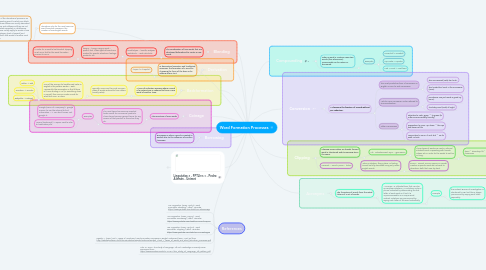
1. derivation is by far the most common word formation process in the creation of new English words.
1.1. the core of the derivational process is an already existing word, to which we attach affixes. These affixes are usually described as prefixes and suffixes and they are not usually listed separately in dictionaries. Such affixes usually apply to words of one lexical category (part of speech) and change them into words of another such category.
1.1.1. Un (prefix) + Happy -> Unhappy
1.1.2. Care + less (suffix) -> Careless
1.1.3. Hallelujah + bloody (infix) -> Hallebloodylujah
2. Backformation
2.1. A type of reduction process where a word of a certain type is reduced to form a new word of another type.
2.1.1. Typically, nouns are the most common cases of words reduced to form others (usually verbs).
2.1.1.1. One of the sources for backformed verbs in English is the pattern worker – work. Apparently, the assumption is that if there is a noun ending in -er (or something close in sound), then we can create a verb for what that noun -er does.
2.1.1.1.1. Editor -> Edit
2.1.1.1.2. Donation -> Donate
2.1.1.1.3. Babysitter -> Babysit
3. Blending
3.1. The combination of two words that are shortened beforehand to create a new word.
3.1.1. breathalyzer→ breath+analyzer, workaholic→ work+alcoholic
3.1.1.1. hangry→ hungry+angry, spork→ spoon+fork. These types of words are created for specific situations, feelings, products, etc.
3.1.1.1.1. In order for a word to be blended, clipping must occur first for this word formation process to occur.
4. Borrowing
4.1. Borrowing is when a word is created in English due to the influence of another language.
5. Linguística 2 - FPTLI03-1 - Pedro Alemán - Unimet
5.1. Group 6: Rodrigues Oriana Rondon Alejandro Muro Luis
6. Coinage
6.1. The invention of new words
6.1.1. The most typical sources are invented trade names for commercial products. These terms become general terms for any version of that product or the action they do.
6.1.1.1. Examples
6.1.1.1.1. Google (name of a company)-> google means “to use the internet to find information.” -> You don’t know? Just google it.
6.1.1.1.2. Aspirin (trademark) -> aspirin used to refer to medication pills.
7. Derivation
7.1. in descriptive linguistics and traditional grammar, the formation of a word by changing the form of the base or by adding affixes to it
7.1.1. “hope” to “hopeful”
8. References
8.1. Aze Linguistics. (2020, April 8). Word Formation: Blending [Video]. YouTube. https://www.youtube.com/watch?v=SdGsvRIEjxI
8.2. Aze Linguistics. (2020, May 27). Word Formation: Borrowing [Video]. YouTube. https://www.youtube.com/watch?v=xXFAfT7qJ3U
8.3. Aze Linguistics. (2020, April 22). Word Formation: Clipping [Video]. YouTube. https://www.youtube.com/watch?v=U7I3zRhagFE
8.4. Zapata, A. (2007) Unit 1: Types of Words and Word-Formation Processes in English. Retrieved (2021, April 29) from http://webdelprofesor.ula.ve/humanidades/azapata/materias/english_4/unit_1_types_of_words_and_word_formation_processes.pdf
8.5. Yule, G., 2010. The Study of Language. 4th ed. Cambridge University Press. Recovered from: https://www.academia.edu/31721811/The_Study_Of_Language_4th_Edition_pdf
9. Compounding
9.1. When a word is creative using two words (free phonemes). Compounds can be native or borrowed.
9.1.1. Examples
9.1.1.1. snow+ball = snowball
9.1.1.2. cup+cake = cupcake
9.1.1.3. Fast + Food -> Fast-food
10. Clipping
10.1. Clipping occurs when an already formed word is shortened and its meaning stays the same.
10.1.1. Ad→ advertisement, Gym→ gymnasium
10.1.1.1. These types of words are used in informal situations such as speaking with friends, videos, etc in order for the words to not be as long.
10.1.1.1.1. dorm→ dormitory, flu→ influenza, rhino→ rhinoceros
10.2. croissant→ French, piano→ Italian
10.2.1. When a situation, thing, place, or feeling cannot be fully described using only native English words.
10.2.1.1. sauna→ Finnish. Since a sauna is a Finnish creation a specific word did not exist to describe a bath that uses dry heat.
11. Conversion
11.1. A change in the function of a word without any reduction.
11.1.1. The most productive form of conversion in English is noun to verb conversion.
11.1.1.1. She microwaved (verb) her lunch.
11.1.1.2. She heated her lunch in the microwave (noun).
11.1.2. Verb to noun conversion is also referred to as nominalization.
11.1.2.1. Sometimes one just needs a good cry (noun).
11.1.2.2. The baby cried (verb) all night.
11.1.3. Other Conversions
11.1.3.1. adjective to verb: green → to green (to make environmentally friendly)
11.1.3.2. preposition to noun: up, down → the ups and downs of life
11.1.3.3. conjunction to noun: if, and, but → no ifs, ands, or buts
12. Acronyms
12.1. The formation of words from the initial letters of a set of words.
12.1.1. "Acronym" is a blanket term that can also encompass initialisms. An initialism is also a phrase indicated by abbreviating the first letter of each word in it, but it is unpronounceable as a unique word. Instead, initialisms are pronounced by saying each letter of the word individually.
12.1.1.1. Example
12.1.1.1.1. the Federal Bureau of Investigation is shortened to FBI, but this is always pronounced by saying each letter separately.
